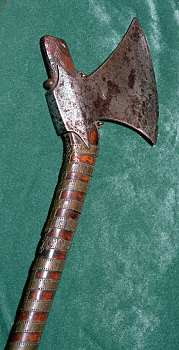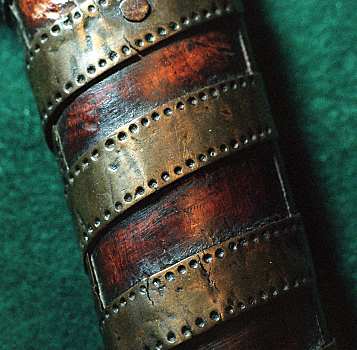In 1604 the Danish/Norwegian King Christian IV issued a law which dictated that all Norwegian men had to arm themselves to serve in a peasant militia in case of attack from (primarily) Sweden on Norwegian soil.
They had the choice of buying a Tessak cheaply from the Crown. Many did, but some chose to go "old school" and armed themselves with battle axes!
These were not viking age "Dane Axes", but a further development with curved handles for slicing cuts. Born were the "Norwegian Battle Axe" or in Norwegian "Bondeøkse/Bondeøks" (= Peasant axe), that was in use even up to 1800.
[in fact they already had this type in use already from the 1500's, but the law massively enlarged production]
These Battleaxes comes in three types (A;B;C) as can be seen on this site:
Source: http://norskevaapen.no/?p=1785
More pictures here:
http://www.maihaugen.no/no/info/kunnskap/saml...apenokser/
Digitaltmuseum (Norway) have a lot of good pictures of these axes:
Source: http://digitaltmuseum.no/search?query=bonde%C3%B8ks
So to show a 1500's example [the axe, not the Norwegian :lol:] - with an axe head still in the viking style.
[ Linked Image ]
Source: http://g.api.no/obscura/API/image/r1/escenic/...56958a.jpg
Last edited by Niels Just Rasmussen on Sat 06 Jun, 2015 6:03 am; edited 1 time in total
Niels, thank you for sharing this! I've seen a photo or two of this axe type, attributed actually to the Viking era, and thought it suspicious that the wood hafts looked so perfect for a Viking-age artifact. Now it all makes sense.
Any ideas on how they got the curvature of the hafts? Steamed, carved, or did they hunt for the perfect branch?
Finally, the location of that last photo looks like trouble brewing - Norwegian with battle axe in front of a Swedish parstuga? It's a beautiful house.
Cheers,
Eric
Any ideas on how they got the curvature of the hafts? Steamed, carved, or did they hunt for the perfect branch?
Finally, the location of that last photo looks like trouble brewing - Norwegian with battle axe in front of a Swedish parstuga? It's a beautiful house.
Cheers,
Eric
So, is this axe also from that period (1600+)? Picture from hurstwick webpage.
 Attachment: 10.84 KB
Attachment: 10.84 KB

 Attachment: 20.1 KB
Attachment: 20.1 KB



| Eric W. Norenberg wrote: |
| Niels, thank you for sharing this! I've seen a photo or two of this axe type, attributed actually to the Viking era, and thought it suspicious that the wood hafts looked so perfect for a Viking-age artifact. Now it all makes sense.
Any ideas on how they got the curvature of the hafts? Steamed, carved, or did they hunt for the perfect branch? Finally, the location of that last photo looks like trouble brewing - Norwegian with battle axe in front of a Swedish parstuga? It's a beautiful house. Cheers, Eric |
Yeah, perfect wood preserved on an axe and still attributed to the viking age would demand extraordinary evidence (professional dig) before being believed. Then type of axe head also plays a major role in dating.
About curvature I would guess (NB: I'm no carpenter) if they located the perfect branch they would off course use that, and if that was not the case they would use other techniques as you say steaming or carving.
Since Scandinavia has a long and strong woodworking mastery tradition the individual carver probably evaluated for each case what would be fitting.
It's not only Danes but also Norwegians that has lost territories to Swedes...... ;) so a little axe-wielding to memorize that fact.
| Luka Borscak wrote: |
| So, is this axe also from that period (1600+)? Picture from hurstwick webpage. |
It very much looks like it is a Norwegian peasant Battle Axe type A. Those at the "digitalmuseum" of that type is attributed from around 1590-1650, with the bulk around 1600-1630.
See: http://norskevaapen.no/?p=1785
Hi Niels. A few questions if you don't mind. Could you tell me how long were the hafts on these peasant axes? Were they a one-handed or a two-handed weapon? Do we have any treatise or description of how they were used? Thanks in advance.
Jason
Jason
| Jason O C wrote: |
| Hi Niels. A few questions if you don't mind. Could you tell me how long were the hafts on these peasant axes? Were they a one-handed or a two-handed weapon? Do we have any treatise or description of how they were used? Thanks in advance.
Jason |
Hi Jason.
Some of the preserved Norwegian peasant axes should be two-handed with a total length around 1 meter (or a sort of hand-and-a-half axe?).
Source (nice curvy one): https://digitaltmuseum.no/011023125374/stridsoks?aq=text%3A%22bonde%C3%B8ks%22&i=102
It is important to note then not all of the axes have original wood, but later inserted wood. A good axe-head itself could have had a long life with several hafts.
You can find some with a later shortened haft bringing the axe down to 50 cm, that then more clearly is in 1-handed territory.
Here is an example with a fairly big axe-head and a short haft, but the haft is not original.
Source: https://digitaltmuseum.no/011021909136/oks?aq=text%3A%22bonde%C3%B8ks%22&i=18
As it was a militia weapon I very much doubt any treatise was ever made for how to use the weapon; but when it comes to descriptions I haven't found anything; but it is certainly possible that some diary descriptions of wars with swedish forces from ~1600-1800 could exist somewhere.
Thanks very much Niels.
Jason
Jason
As a Norwegian I approve of these :-) These axes were always a status symbol when not used in war. Very many of them are lavishly decorated, often with finely tooled silver. Lenght is as stated about 1-ish meter. They were used as walking sticks for Sunday displays so thats about the length.
Note that the tip of the axe is almost always perpendicular with the shaft, forming a hefty spear point for stabbing. The axe heads are also surprisingly thin making this a very agile and fast weapon and not a brutish cleaver.
The angle of the shaft was probably done in many ways, but traditionally it should be from rowan. Root shots of some hard woods like ash and rowan grows at a perfect initial angle from the old root. I have made a few rowan replicas with shafts cut straight from the forest, no adjustment of angle required.
Note that the tip of the axe is almost always perpendicular with the shaft, forming a hefty spear point for stabbing. The axe heads are also surprisingly thin making this a very agile and fast weapon and not a brutish cleaver.
The angle of the shaft was probably done in many ways, but traditionally it should be from rowan. Root shots of some hard woods like ash and rowan grows at a perfect initial angle from the old root. I have made a few rowan replicas with shafts cut straight from the forest, no adjustment of angle required.
| Tjarand Matre wrote: |
| As a Norwegian I approve of these :-) These axes were always a status symbol when not used in war. Very many of them are lavishly decorated, often with finely tooled silver. Lenght is as stated about 1-ish meter. They were used as walking sticks for Sunday displays so thats about the length.
Note that the tip of the axe is almost always perpendicular with the shaft, forming a hefty spear point for stabbing. The axe heads are also surprisingly thin making this a very agile and fast weapon and not a brutish cleaver. The angle of the shaft was probably done in many ways, but traditionally it should be from rowan. Root shots of some hard woods like ash and rowan grows at a perfect initial angle from the old root. I have made a few rowan replicas with shafts cut straight from the forest, no adjustment of angle required. |
Like the Dane Axes before it, it was clearly a weapon and not a tool; thus very thin axe-heads and lightweight needed for making fast movements.
Great observation with the bend head making these axes both useful as a spear, and probably also making the edge of the axe more suited for long slicing cuts.
Nice detail with people proudly showing them off as walking sticks when going to church (I reckon it's what you mean by Sunday displays). I mean a "våbenhus" in a church is to be used, so all can admire your axe when you proudly put it there.
It wasn't the richer farmers that used them (having tessacks and wheellocks instead), but a very nice status symbol of being a "man" nonetheless.
It might interest you to know that the rowan was in viking age time especially attributed to Thor ("the salvation of Thor").
It's red berries complemented the red beard of Thor.
But thanks for the wood-work knowledge (where I'm very lacking). Ash was very common for spears, so I suppose it is a great wood for straight axe-hafts as well. But is it possible to get the end-bend with ash-wood? Or is here rowan the best wood.
So perhaps straight shaft from ash and bend shafts from rowan?
You do see bondeøkser with both shapes in the collections....
I would like to see one of your replicas ;)
Page 1 of 1
You cannot post new topics in this forumYou cannot reply to topics in this forum
You cannot edit your posts in this forum
You cannot delete your posts in this forum
You cannot vote in polls in this forum
You cannot attach files in this forum
You can download files in this forum
All contents © Copyright 2003-2006 myArmoury.com — All rights reserved
Discussion forums powered by phpBB © The phpBB Group
Switch to the Full-featured Version of the forum
Discussion forums powered by phpBB © The phpBB Group
Switch to the Full-featured Version of the forum